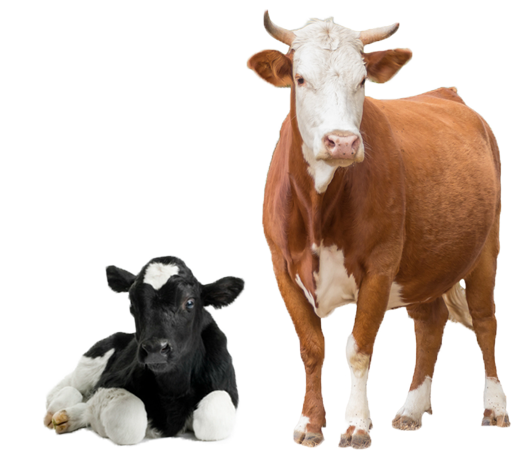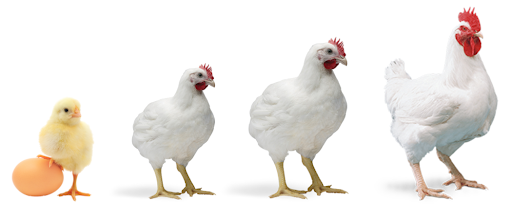Laboratory Testing of CBFeed as a Feed Component
Laboratory studies in Uzbekistan and Japan have shown that CBFeed is safe for animals (as feed) and for humans (as meat products derived from these animals).
Results of all experiments confirmed that CBFeed is well digested and safe for animals. In all experiments the analysis of the final product (meat, milk, eggs) was performed. The end products were tested for safety standards - such as physical-chemical, microbiological, radiological, pesticide, bacteriological, parasitological.
Starting 2017, Natural Ventures Pte. LTD conducted a number of tests on cattle, broilers, laying hens and turkeys in Uzbekistan.
In 2018, CBFeed samples were examined in Japan.
The results of the main laboratory tests are presented below.
CBFeed test conducted on cattle
CBFeed test conducted on poultry
Test reports for downloading
Results of laboratory tests of CBFeed in the Republic of Uzbekistan
The safety of CBFeed for animals is confirmed not only by government inspection bodies and internal research, but also by animal feed manufacturers and broiler farms.
CBFeed tests conducted on cattle

| 2017-2019 | Tests on calves July - September 2017 (3 months) |
Tests on cows August 2017 (45 days) |
Tests on cows March – June 2019 (2 months) |
| Purpose –CBFeed evaluation: | Digestibility, consumption and safety (3 months) | Effect on cow's milk. | Effect on cow weight and milk indicators (fat content, skim milk residuals, protein, etc.) |
| Experiment group: | Calves in the age of 12 -14 months (8 calves) | Cow (one) | Four cows of the Goldstein breed |
| Diet: | Three diet components were the same for all test animals — hay, clover, and meal. The fourth product was different: - Component 1: wheat - Component 2: raw RH - Component 3: raw RH + raw rice bran - Component 4: raw RH and raw meal after biological treatment using CBFeed technology - Component 5: raw RH after biological treatment using CBFeed technology. |
Gradual introduction of CBFeed into standard diet | The diet changed over time in the following way: - 4 weeks: the diet consisted of clover, hay, bran, and complete mixed feed for cows. - 3 weeks: 50% of the feed was replaced with CBFeed, while CBFeed accounting for 30% of the total diet (feed weight was equal to the control weight). - 2 weeks: CBFeed amounted to 50% of the total diet (feed weight exceeded the control weight, the cost of the final diet remained as in the control feed) |
| Organization conducting analysis: | National Veterinary Laboratory of the Republic of Uzbekistan Independent laboratories of the Republic of Uzbekistan (radiology, biochemistry, physical and chemical composition) |
PS «RAMZIT» independent laboratory of Tashkent region sanitary and epidemiological service | Tashkent region sanitary and epidemiological service «УСЭН ГМУ» under the Administration of the Presidetn of the Republic of Uzbekistan |
| Result: | CBFeed is well digested, eaten and safe for animals | CBFeed has a beneficial effect on fat increase in cow's milk. Milk fat content in the experimental group increased from 3.5% to 5.2% in the reporting period. |
The amount of feed eaten has increased by 15%, but the total feed cost per day has not changed. Feeding cows within 50% CBFeed of the total cow diet per day increases fatness, protein and skim milk residuals, which has a beneficial effect on the final price of the finished product. Milk fat content has increased to 4.1%. |
CBFeed tests conducted on poultry (broilers, layers, and turkey)

| 2017-2019 | Tests on broilers March-April 2019 (45 days) |
Tests on broilers April – May 2019 (2 months) |
Tests on turkey March – June 2019 (3 months) |
| Purpose –CBFeed evaluation: | - Effect of CBFeed feed on broilers at different stage of growth (Start, Growth and Finish). - Set the minimum and maximum CBFeed percentages in the ration for effective use as a replacement for more expensive feed types. - Effect of feed on the performance of broilers and on the final product (meat) - Check of broilers meat product for proteins, carbohydrates, and taste. |
Effectiveness on broilers performance/productivity | Effectiveness on turkey’s weight |
| Experiment group: | Broilers (1050 broilers) | Broilers (10 000 broilers) | Turkey (42 one-month old turkeys) |
| Diet: | Replacement of the share of the basic diet (from 2.5% to 50%) by CBFeed. For example, 20 kg of feed was removed from a 100 kg ready-made complete feed and 20 kg of CBFeed was added. A total of 21 such rations were developed for each of the Start, Growth and Finish stages. | Replacement of the portion of the main diet with CBFeed: -growth stage – 6 and 9% CBFeed -finish stage – 12% CBFeed |
Different diets were assigned to 6 groups (7 in each). The percentage of CBFeed added to the feed ranged from 0% to 40%. |
| Organization conducting analysis: | Sanitary and epidemiological service of the Republic of Uzbekistan SGS* Tashkent LTD «AGRO KORM UNIVERSAL LLC» - animal feed manufacturer |
«OQDil Max LLC» - broilers farm | SGS* Tashkent LTD |
| Result: | Cost savings on broilers feed while maintaining the weight gain dynamics. Not only does CBFeed digest itself, but it also facilitates the absorption of the main feed. |
CBFeed is well digested and favorably affects the increase in weight of broilers. | It is possible to feed turkey species with the addition of CBFeed up to 40%. The weight gain of the turkey remains satisfactory. |
Conducted analyzes & Test reports
| Production tests report of feed additive "CBFeed" on broilers crosses Ross-308 and COBB-500 in different farms of the Republic of Uzbekistan (2020) |
Download (RU/EN) |
| Laboratory analyzes of CBFeeD in Japan | Download (JP/EN) |
| Report on Inspection by «SGS» | Download (RU/EN) |
| Characteristics of different types of feed and CBFeeD | Download (RU) |
| Protocol on results of stabbed bull №3614 | Download (UZ/EN) |
| Protocol on results of stabbed bull №3649 | Download (EN) |
| Broiler meat test report(№225) | Download (RU/EN) |
| Broiler meat test report - Sanitary and hygienic (№645) | Download (RU/EN) |
| Broiler meat test report - Sanitary and hygienic (№683) | Download (RU/EN) |
| Broiler meat test report - Bacteriological laboratory (№979) | Download (RU/EN) |
